Motorola RAZR XT910 review: Through thick and thin
Through thick and thin
Completely redesigned UI
The Motorola RAZR came with Android 2.3.5 Gingerbread out of the box and a completely new user interface. It's quite nice, with helpful tools to streamline your interaction with your phone but we missed some functionality in some places too.
Before we go on, here's the user interface in action to give you an idea of what we're dealing with.
The lock screen is one area where Moto improved on the generic Android solution - you have two horizontal sliders (one for unlock and one to launch the camera) and a ringer toggle in the middle. It's not as multifunctional as HTC's solution, but it beats most other lockscreens we’ve seen.
The homescreen consists of five side-scrollable panes. As you move between them, there's a nice animation complete with shadows to give it a feeling of depth. A tap on the Home key brings you to the middle pane and another tap launches the preview mode so you can quickly skip to any homescreen you want.
What you can't do here is add or remove homescreen panes or use a pinch-zoom gesture to launch the preview mode (you always have to do that with the Home key on the middle pane). You can't rearrange panes while in preview mode either.




The RAZR's homescreen • Preview mode
The Motorola RAZR comes with a long list of custom widgets to place around the homescreen. Widgets can be resized freely. All you need to do is hold a finger over a widget. Resizing a widget also changes its appearance. Depending on the widget, it can display more or less info when resized.




Choosing a widget • Widgets can be adjusted to be bigger or smaller
You also get the full set of Android widgets available on the RAZR. They cannot be resized like the custom-made Motorola widgets.
The notification area swipes down from the top, as usual. It's a clean, unmodified notification area - no quick toggle buttons or anything like that in here.
At the bottom of the screen there is dock with four shortcuts - the rightmost one always brings up the app drawer, but the other three you are free to replace with whatever app you want (even a bookmark or a playlist).
As a final extra shortcut, you can also set up the Home key to launch an app on double tap.




Notification area • Shortcuts dock at the bottom of the screen
Speaking of the app drawer, it consists of several pages that can be scrolled horizontally. Each page is a 4 x 5 grid of icons. Apps can be sorted alphabetically, there're other filters as well, including frequently used and recent. The pre-installed apps can also be hidden (those go in the Hidden apps screen that can be accessed from the context menu). The app drawer also features a shortcut to the Market.
A cool feature is Groups - the default ones are All apps, Recent (that's the redesigned task switcher that the Motorola RAZR uses) and Downloaded. You can create custom groups (and assign them custom icons). Later you can put those groups as shortcuts on the homescreen or even in the app dock at the bottom to create an alternative app drawer.
Like we said, the Recent group serves as a task switcher. That's good because it uses the same 4 x 5 grid of icons and fits much more than the standard 2 x 3 task switcher of Android.
There's a Task Manager too. It has two tabs - Applications and Auto-end list. You can select multiple apps and kill them or add them to the auto-end list. Apps on that list will be killed 2 minutes after you lock the screen.
One really nifty feature that's popular on BlackBerries is the In-pocket detection - the phone will use its proximity and ambient light sensors to detect when you slip it into your pocket (or purse or whatever) and it will automatically lock itself. Note that the phone has to be vertical for this feature to trigger (to avoid mis-predictions if you put the phone face down on the table).

In-pocket detection is a very businessy feature
Synthetic benchmarks
The Motorola RAZR is powered by a Texas Instruments OMAP 4430 chipset. In it, there are two Cortex-A9 cores running at 1.2GHz, 1GB of RAM and a PowerVR SGX540 GPU. It sounds like a nice setup - let's see what our benchmarks will show.
We ran the single-threaded BenchmarkPi and the muti-threaded Linpack benchmarks and the Motorola RAZR managed to beat the HTC Sensation XE (which has two 1.5GHz CPU cores) but was behind Samsung's custom Exynos chipset.
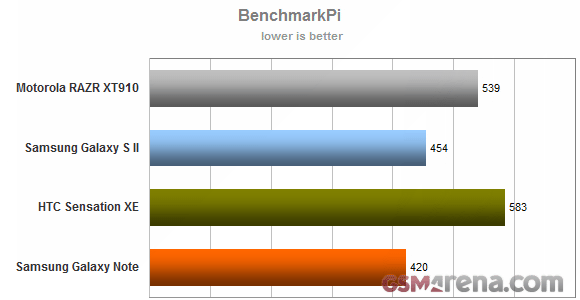
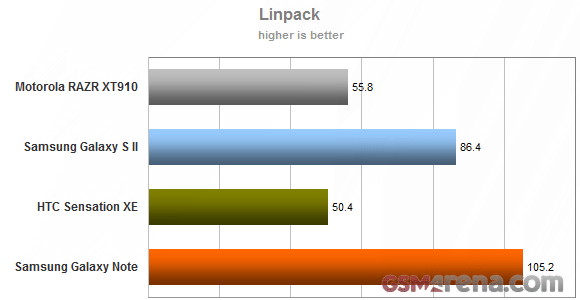
For the 3D benchmark, the RAZR is at a bit of a disadvantage compared to the Galaxy S II as it uses a higher qHD resolution (same as the Sensation XE). The GPU bested the Adreno 220 in the Sensation XE but couldn’t top 30fps (keep in mind that benchmarks are usually heavier than actual games).
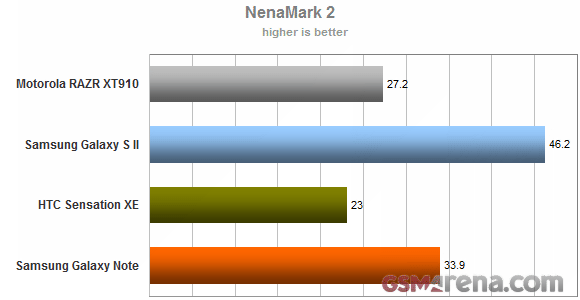
The JavaScript engine in the RAZR's browser proved rather good as it matched the performance of the Galaxy S II (despite the lower CPU scores). The Motorola RAZR was ahead of the Sensation XE here, but HTC's browser does best in the combined HTML5 benchmark, BrowserMark.
There the RAZR came a distant second, but ahead of Samsung's offerings (even the faster clocked Exynos in the Note). This goes to show you it's not all about raw power - software optimization goes a long way.
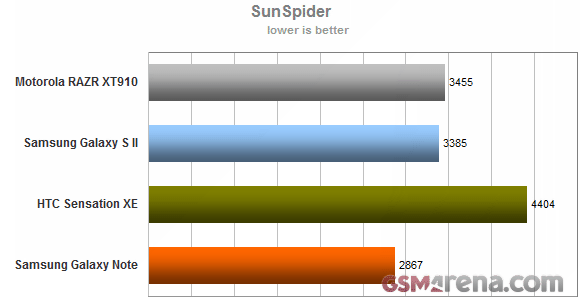
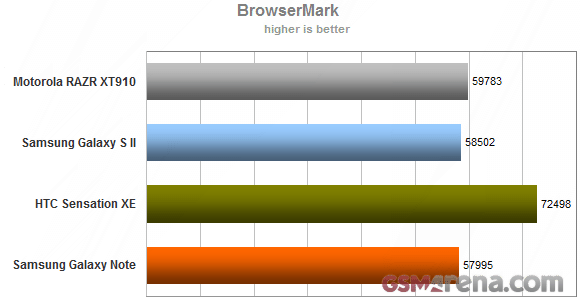
Reader comments
- gautam Kumar
- 13 Jun 2016
- Hkt
hii. my mobiles battree is cut broke a. nd l? eb20 battery for motorola droid razr xt910 xt912 with 1750mah
- Darryl xt910 moto
- 05 Feb 2015
- QyT
Hold the power button down for 10 secs and it will reboot.. hope this helps you.
- AnonD-288795
- 30 Jul 2014
- v0q
Good day, I would like to ask how to resolve this problem? My xt910 once drained wont turn on already,one time i had it checked and the technician pulled out the battery and charged it directly. Right now it is drained again,is there a stuff i ...










